There is a myth about parenthood.
It goes something like this: You will be able to have children when (and only when) you want. Your experience having children will follow the pathway you choose for it. Your children will be healthy.
Reality, as our community frequently notes, is quite different from the myth. Pregnancy loss is one place of divergence. Losing a pregnancy is scary when we experience it, or when those close to us experience it.
While there have been notable figures who take the brave step of grieving their experience in public, their grief is often scary for others (the mixed responses to Chrissy Teigen and John Legend’s decision to publicly announce and grieve their miscarriage is a recent example).
My experience as a grieving father has been that when reality diverges from myth, it is more valuable to exchange stories than it is to seek prescriptive answers.
To that end, here are some of the themes that have shaped my journey to parenthood.

This site contains affiliate links, meaning that we earn a small commission for purchases made through our site. We only recommend products we personally use, love, or have thoroughly vetted.
- Fatherhood and Pregnancy Loss: My Story
- Rapids of Grief in our Marriage: Some Sources of Turmoil
- Riding the Rapids of Grief: Some Sources of Healing
- Friend or Enemy?: The Role of Body Image in Pregnancy Loss
- The Open Hand: in Marriage, in Pregnancy, in Parenthood
- In Summary: The Reality of Pregnancy Loss
Fatherhood and Pregnancy Loss: My Story
Am I a Real Father?
My wife Kristine and I had two miscarriages, followed by two daughters, followed by a third miscarriage, followed by a third daughter.
When we experienced our first miscarriage, I believed that Kristine’s loss was more real than mine. After all, she had to deal with both physical and emotional loss.
Nonetheless, in response to the miscarriage, as I had done for many years with both mundane and formative events, I wrote in my journal.
I used the form of writing a letter to my unborn child – again following my habit of treating my journal as a letter to a friend. As I wrote about the pregnancy and miscarriage, I saw the hopes, fears, dreams, and grief all come together.
This helped me claim my identity of grieving father. It reinforced to me that Kristine was the mother of my child. It helped me grant identity to our unborn child as a real child, and not simply an abstract possibility.
Showing my letter to Kristine helped to communicate my tangled emotions about parenthood to her in ways that verbal conversations hadn’t.
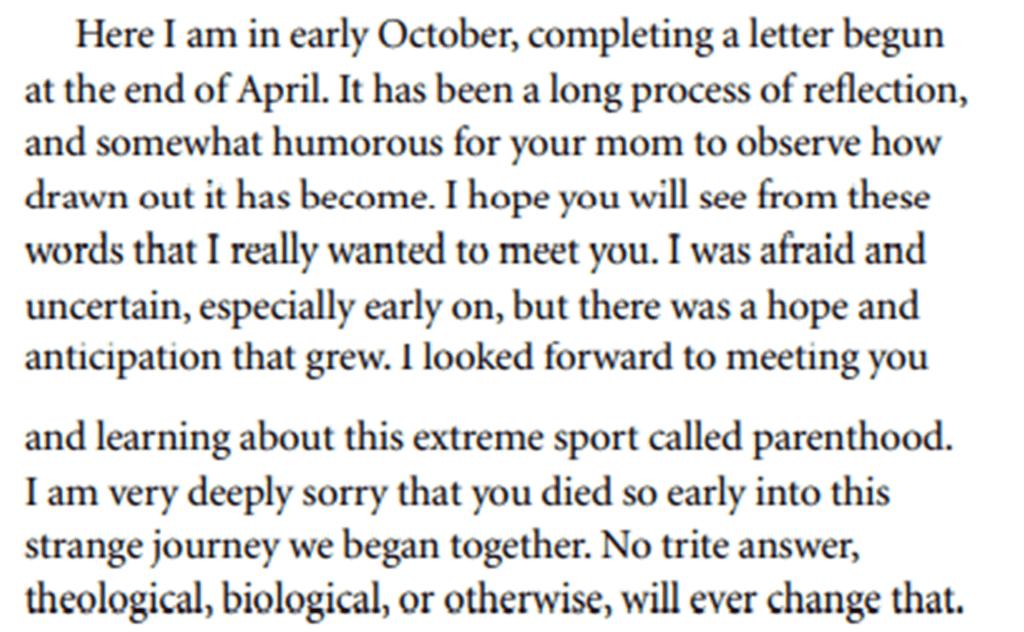
The Encouragement and the Rebuke: You Are Not Alone
When we had our first miscarriage, the doctors said we were statistically normal, as one in four pregnancies end in miscarriage. We certainly didn’t feel statistically normal, but I hoped that since we had paid our dues, we could move on.
Our second miscarriage forced me to face the possibility of never being a biological parent. I responded with anger.
One evening, over dinner with a close friend from work, I shared some of what I had learned:
- Miscarriages happen in twenty to thirty percent of pregnancies.
- They are stigmatized in daily life.
- As a public health phenomenon, they receive very little attention. Resources get diverted to other causes with more glamor appeal.
My friend had a sympathetic look in his eyes as he said “I know how you feel. My mother has been a tuberculosis advocate in rural Massachusetts for many years. I’ve watched her face similar dynamics.”
I wanted the world to owe me something because of our two miscarriages. By gently telling me that I was not alone, my friend both rebuked and encouraged me.
But when we had our third miscarriage, my reaction changed from anger to despair.
I resented people around me who had children. I resented everything vocationally that represented having dreams or taking risks.
My raw emotions simply said “I’m done hoping and trying hard things. I’m just plain done.”
During this period, I met a friend from church for lunch. When he asked how I was doing I told me about our most recent miscarriage, and a little about my despair.
He said “I know how you feel. We wrestled with infertility for a while, and had several miscarriages before our children were born. We didn’t know if we would ever be parents, and here we are with four girls.”
Once again, my friend’s words provided both encouragement and gentle rebuke to not be so consumed by my pain that I didn’t see where others around me shared similar grief and pain.
Rapids of Grief in our Marriage: Some Sources of Turmoil
Help That Wasn’t Helpful
Kristine and I wanted to support each other through the miscarriages. Yet we found that the myth of spousal support didn’t match the reality of grieving in different ways and at different times.
I drew parallels between my miscarriage grief and workplace dynamics at my employer, which was going through a downturn.
This convergence of grief and what was going on at work created a path for my dissertation research, and it gave me language for living in a world with uncertainty, events that are not predictable, and problems that can’t always be solved.
Using the parallels between what was going on at work and what was happening in my life was a meaningful worldview for me; one that I hoped would solve Kristine’s grief.
It didn’t.
She had a different set of questions, to which my constructs were between meaningless and harmful. That was disappointing for me. I wanted to support her. I wanted to help her in her grief. I felt like I was letting her down.
It was also scary for me. We had experienced the same events, and yet her path to meaning was not the same as mine. I wondered if my experience was legitimate.
Childhood Stories That Negatively Reinforced One Another
Many years later, through help from a caring therapist, we were able to use the language of our own childhood stories to understand some of the unhelpful help we gave each other while struggling with miscarriage.
One of my dominant childhood stories is that I am alone, and that I cannot expect anyone to help me solve my problems.
One of Kristine’s dominant childhood stories is that she needs to fix things and make them right. These stories were combined with aspects of a shared faith tradition which emphasized personal responsibility when facing hardship (e.g., “if God feels distant, guess who moved?).
My feeling alone led to withdrawal, which signaled to Kristine that she wasn’t solving my problems.
Our prayers were bloody knuckles beating on a closed door.
The stories and faith tradition had been adaptive patterns into our young adulthood. They were destructive when we encountered pregnancy loss.
Riding the Rapids of Grief: Some Sources of Healing
Madeleine L’Engle (A Wind at the Door, A Swiftly Tilting Planet) and J. R. R. Tolkien (The Silmarillion) both portray evil as darkness and chaos that bring disorder into the world.
Goodness responds not by overpowering evil, but with a creative force that speaks beauty and order into the chaos.
Those motifs helped us craft our response to the darkness and chaos of miscarriage. The negatively reinforcing narratives are less powerful as we have engaged these areas.
Finding Beauty
Kristine’s creative response has been through visual beauty.
For our tenth wedding anniversary we commissioned a family portrait from Indianapolis artist Kyle Ragsdale. Kristine asked him to include three crocuses in the painting as symbols of our unborn children.
Like the crocuses, these little ones were beautiful, fragile, and they didn’t last long.
Including the crocuses in the painting was a way for us to love our unborn children and claim them as part of our family. The painting has held a place of honor in our living room through moves from Indianapolis to the UK, and back to Indianapolis.
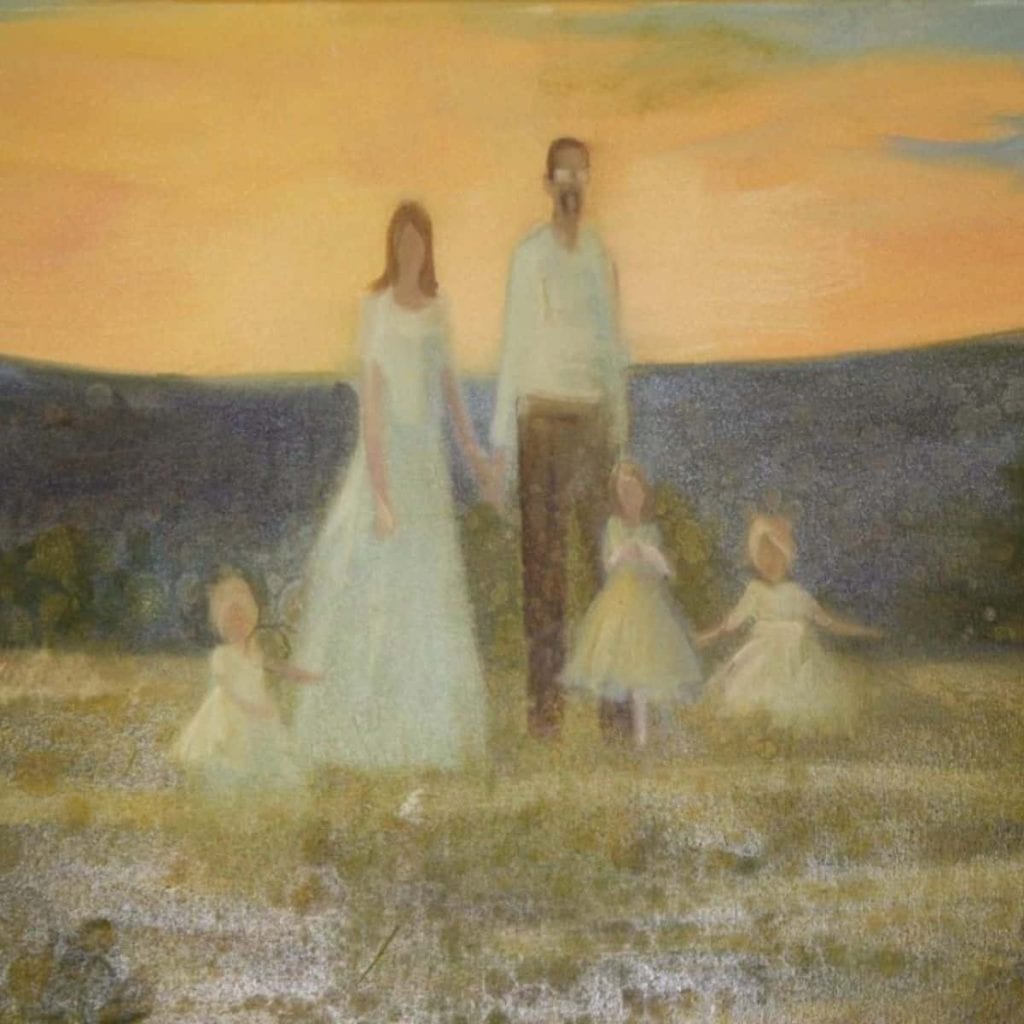
Liturgical music is the creative force for me that visual beauty is for Kristine. I am a competent, but not expert, instrumental music hobbyist.
It has been healing for me to find songs by others who have experienced pregnancy loss, to put my own music to existing texts, and to arrange and perform songs in virtual ensembles.
“Caim Prayer,” Written After Our Third Miscarriage in 2010
“Planting a Garden,” from The Crossing’s Dochas album, was one of our laments for many years. I arranged and recorded it in 2021.
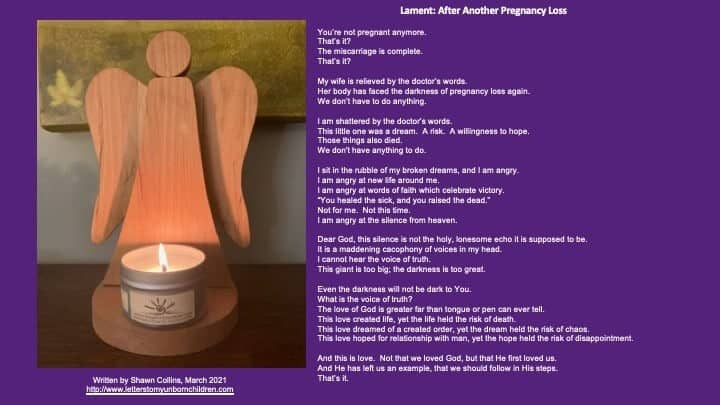
Friend or Enemy?: The Role of Body Image in Pregnancy Loss
Body image was also a source of pain through our pregnancy losses and subsequent pregnancies.
It also became a place where we are learning to find healing.
Kristine and I brought shame gremlins (to borrow Brené Brown’s term) about our physical bodies with us into marriage.
My 6’5” frame and its growth spurts through my youth included a sense of clumsiness, which embedded a message that my body was my enemy. I needed to overcome this feeling.
The Biblical motif of the man and woman being naked and unashamed brought some healing early in our marriage. The miscarriages shattered that.
My body, which had been my enemy for so long, was responsible for the death of my child, and for the pain that Kristine, my best friend, experienced.
While I understood that the miscarriages were not medically my fault, it didn’t stop the emotional messages from the shame gremlins.
Kristine’s gremlins had different messages. Her body didn’t carry the pregnancies. Her body didn’t completely miscarry the first two pregnancies, so we had to have D&C’s.
She felt like her body had let her down.
Our words of attempted comfort to each other were similar: I love you. I believe you are beautiful (handsome). Please don’t falsely criticize yourself like this.
Those words, while meant in love, did not speak comfort that either of us could consistently hear.
The turning point was when one of Kristine’s friends gave her a copy of Why Beauty Matters by Karen Lee-Thorp and Cynthia Hicks.
The book debunks false baggage from the Evangelical faith tradition about how women should be of sound mind, good character, and not worry about a physical flesh that is evil.
It offers an alternative narrative: physical bodies being part of the good creation, the presence of physical bodies in both the Incarnation and Resurrection. The idea of the physical body as a gift to be cherished and nourished, even when it is flawed, changed our paradigm.
This book enabled us to be gracious with ourselves and each other in ways that we hadn’t before.
That paradigm guided our interactions with our daughters through toddlerhood and now into their teenage years.
It doesn’t prevent them from having feelings of physical inadequacy, but it does give us language to try and help them be gracious with themselves when they face those feelings.
Our experience, shaped by a family of daughters, is not unique. I hope that someday a book called The Importance of Being Handsome will provide a similar paradigm for men and parents of boys.
The Open Hand: in Marriage, in Pregnancy, in Parenthood
When Kristine and I began dating, we wrestled with a tension between the desire for a relationship and the desire to protect ourselves from hurt.
We are both first born children. We are both trained in vocational fields (mechanical engineering for me; pharmacy for her) that place a high priority on containing risk.
We also knew that we did not want our relationship to be governed by fear. The open hand was a symbol that helped us live with this tension. We used it to frame our decision to enter the unknowns of dating, and later of engagement and marriage.
Part way into grieving our second loss I realized that I had to decide whether I would honor that commitment to hold Kristine with an open hand.
She was not grieving like I was, or like I wanted her to. I was not helping her like I felt like I should.
Would I hold her with an open hand and accept the relational risk that miscarriage was making us live with, or would I let my childhood story of isolation guide my steps down a path of withdrawal?
The question of holding Kristine with an open hand also led to a question of holding my child with an open hand.
Would I love each little one as my child, even if I never got to meet them? This was a brutal question to ask myself during weeks of ultrasound visits when we didn’t know if the miscarriage was real yet.
If I said “No,” then what were the conditions I was placing on my love? Full term pregnancy? Healthy childbirth that included a birth experience which our peers found acceptable? Living long enough after birth to convince me they weren’t going to die?
Growing into childhood and exhibiting talents and interests which mirrored mine? The opportunities to say “I will only love you if …” were endless.
The open hand was encouraging when I looked at the uncertainties of dating and marriage. It was not so encouraging when I looked at the uncertainties of miscarriage. Nonetheless, it was a disciplined choice I needed to make (again, and again).
The alternative, saying “I will only love you if you prove you won’t hurt me,” wasn’t something I was willing to choose.
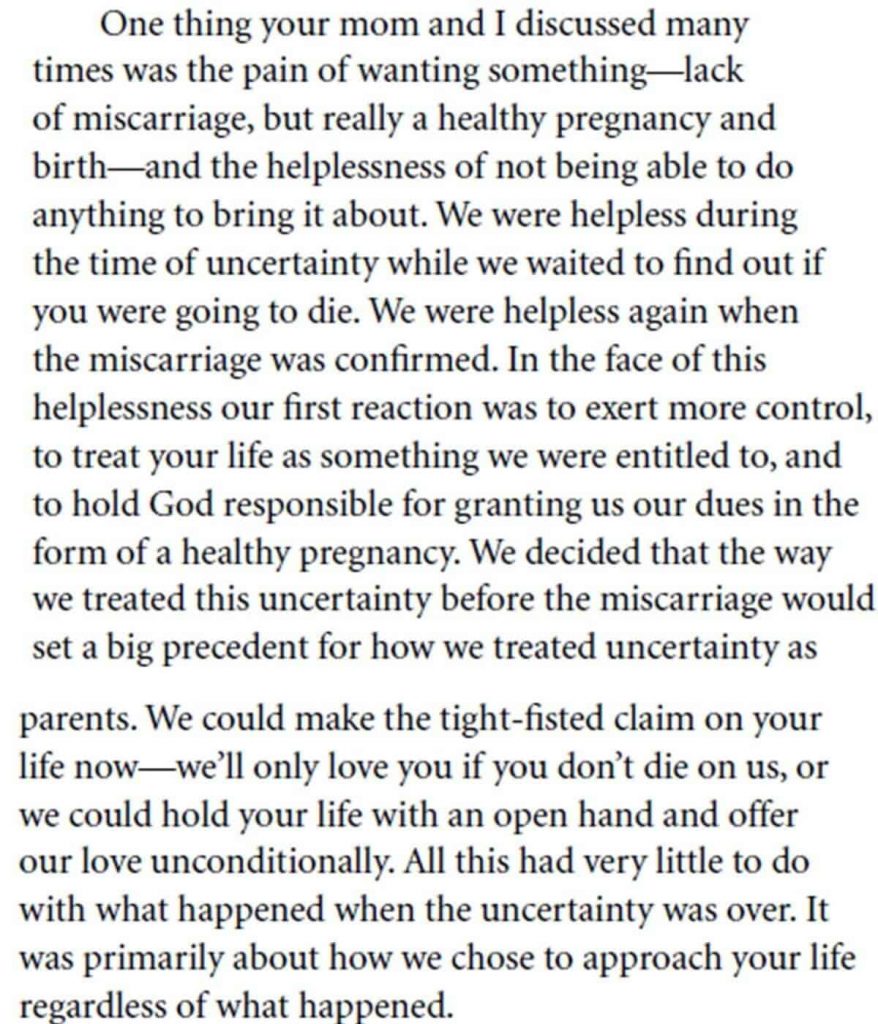
In Summary: The Reality of Pregnancy Loss
Pregnancy loss is real. If you are reading this article on Undefining Motherhood, you know that better than most.
The journey through loss, when it happens, is unique. Mothers grieve in different ways from each other. Parents grieve in different ways from each other. Fathers grieve in different ways from each other.
This uniqueness of grief does not mean we grieve alone.
I hope that the parts of my story you’ve read here offer some encouragement as you navigate your own rapids along the journey into parenthood, whatever shape that takes.
The light shines in the darkness, and the darkness has not overcome it.
Shawn Collins, PhD, is the author of Letters to My Unborn Children: Meditations on the Silent Grief of Miscarriage (http://www.letterstomyunbornchildren.com). He lives in Indianapolis with his wife Kristine and their three daughters. In addition to his vocational work in the aerospace industry he also writes about organizational behavior and pregnancy loss for both academic and lay audiences.

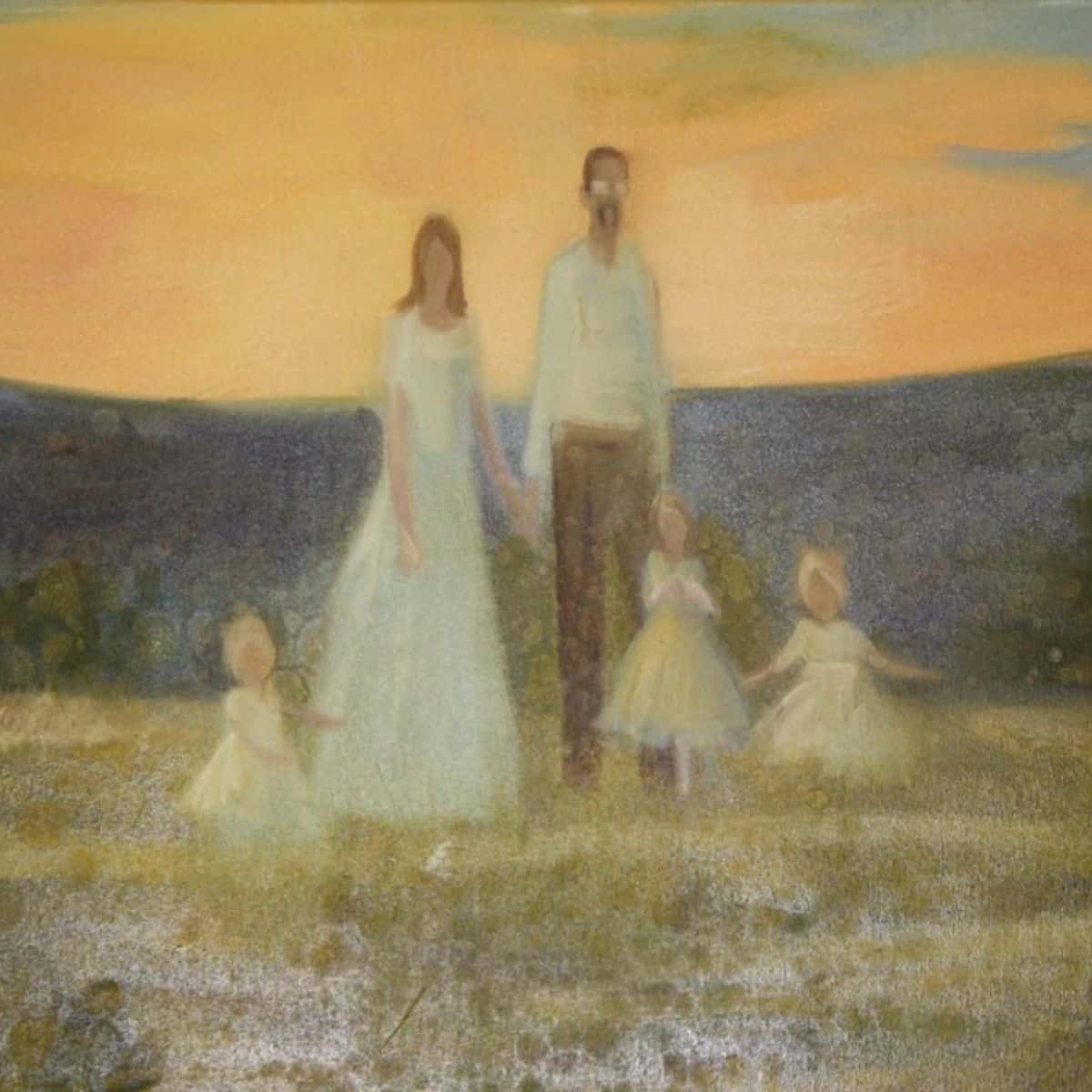







One thought on “A Father’s Journey With Pregnancy Loss: Evolving Emotions, Marriage Rapids, and Redemptive Grief”